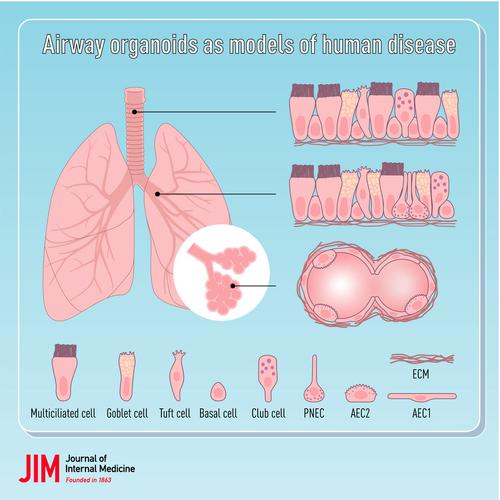当前位置:
X-MOL 学术
›
J. Intern. Med.
›
论文详情
Our official English website, www.x-mol.net, welcomes your
feedback! (Note: you will need to create a separate account there.)
Airway organoids as models of human disease
Journal of Internal Medicine ( IF 9.0 ) Pub Date : 2020-04-29 , DOI: 10.1111/joim.13075
J van der Vaart 1 , H Clevers 1, 2
Journal of Internal Medicine ( IF 9.0 ) Pub Date : 2020-04-29 , DOI: 10.1111/joim.13075
J van der Vaart 1 , H Clevers 1, 2
Affiliation

|
Studies developing and applying organoid technology have greatly increased in volume and visibility over the past decade. Organoids are three‐dimensional structures that are established from pluripotent stem cells (PSCs) or adult tissue stem cells (ASCs). They consist of organ‐specific cell types that self‐organize through cell sorting and spatially restricted lineage commitment to generate architectural and functional characteristics of the tissue of interest. The field of respiratory development and disease has been particularly productive in this regard. Starting from human cells (PSCs or ASCs), models of the two segments of the lung, the airways and the alveoli, can be built. Such organoids allow the study of development, physiology and disease and thus bridge the gap between animal models and clinical studies. This review discusses current developments in the pulmonary organoid field, highlighting the potential and limitations of current models.
中文翻译:

气道类器官作为人类疾病模型
在过去的十年中,开发和应用类器官技术的研究在数量和知名度方面都大大增加。类器官是由多能干细胞 (PSC) 或成体组织干细胞 (ASC) 建立的三维结构。它们由器官特异性细胞类型组成,这些细胞类型通过细胞分选和空间受限的谱系承诺自组织,以产生感兴趣组织的结构和功能特征。呼吸系统发育和疾病领域在这方面特别富有成效。从人类细胞(PSC 或 ASC)开始,可以构建肺的两个部分、气道和肺泡的模型。这种类器官允许研究发育、生理学和疾病,从而弥合动物模型和临床研究之间的差距。
更新日期:2020-04-29
中文翻译:

气道类器官作为人类疾病模型
在过去的十年中,开发和应用类器官技术的研究在数量和知名度方面都大大增加。类器官是由多能干细胞 (PSC) 或成体组织干细胞 (ASC) 建立的三维结构。它们由器官特异性细胞类型组成,这些细胞类型通过细胞分选和空间受限的谱系承诺自组织,以产生感兴趣组织的结构和功能特征。呼吸系统发育和疾病领域在这方面特别富有成效。从人类细胞(PSC 或 ASC)开始,可以构建肺的两个部分、气道和肺泡的模型。这种类器官允许研究发育、生理学和疾病,从而弥合动物模型和临床研究之间的差距。

































 京公网安备 11010802027423号
京公网安备 11010802027423号